深度阅读
应对洪水:文化遗产的全球威胁


应对洪水:
文化遗产的全球威胁
Tackling Floods:A Global Threat to Cultural Heritage

减轻文化遗产洪水风险课程取得重大进展,以保护各种形式的遗产免受洪水威胁。
2023年9月22日至30日,国际文化遗产保护与修复研究中心(ICCROM)的“危机时期文化遗产的急救与韧性”(FAR)项目在克罗地亚的特罗吉尔组织了一场混合课程,主题是减轻洪水风险。该课程由克罗地亚共和国文化和媒体部与ICCROM合作举办,并得到了加拿大保护研究所(CCI)和中国国家文物局的大力支持,汇集了来自6个国家的14名参与者。这些国家包括加拿大、克罗地亚、马耳他、印度、波兰和罗马尼亚,它们都面临着由气候变化和城市化等多种因素加剧的迫在眉睫的洪水风险。
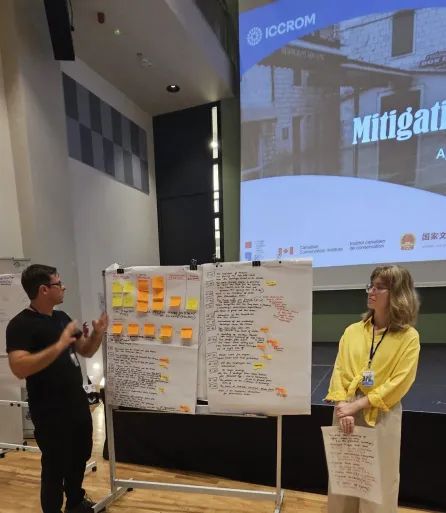
洪水已成为全球文化遗产面临的最严重且最频繁的威胁之一。继2022年火灾风险缓解课程成功举办之后,“PREVENT:遗产洪水风险缓解”课程作为PREVENT系列的第二期,旨在应对这一日益严峻的挑战。今年以洪水为重点,突显了立即采取集体行动保护各种形式遗产的紧迫需求。
通过PREVENT系列课程,旨在促进不同领域专业人士之间的合作,为他们提供专业培训和资源,以应对各地区洪水风险管理的独特挑战。培训重点在于了解洪水风险的成因,并在文化遗产地实施具成本效益的缓解措施和应急准备策略。
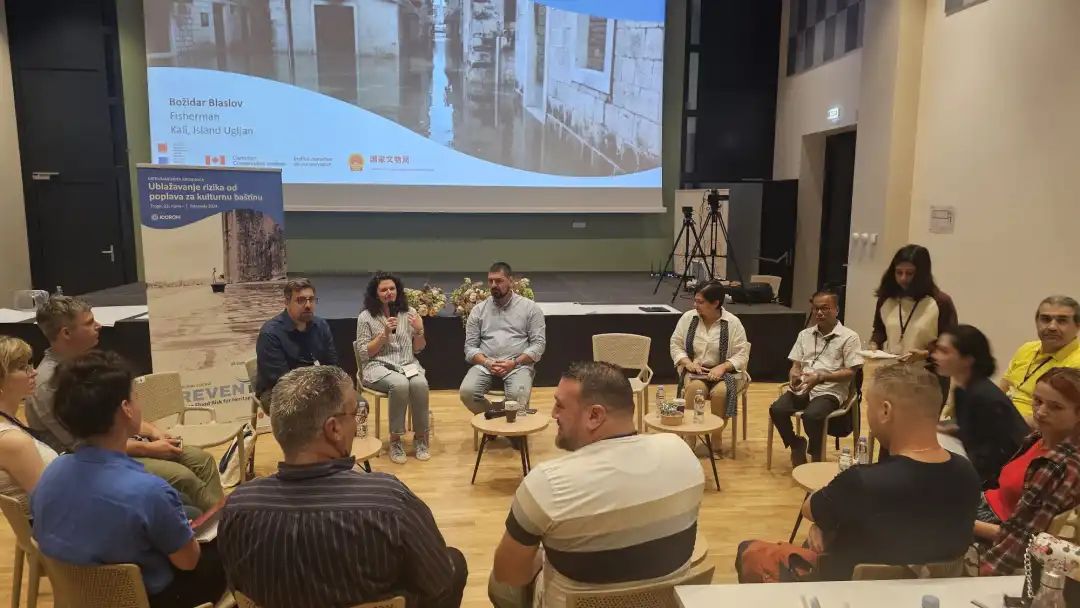
PART.01
一种协作式学习体验

现场课程开始前,参与者先参加在线指导以了解相关概念,内容涵盖灾害与气候变化的交集、风险评估要素,以及展示气候变化对文化遗产影响的全球案例研究。
在为期一周的课程中,参与者进行了理论讨论和实践模拟。他们专注于评估文化遗产地的洪水风险,分析文化遗产在洪水风险中的脆弱性,并制定风险情景。课程还强调了传统知识、社区主导策略以及文化遗产地洪水应急响应的重要性。到课程结束时,每个小组都制定了一个针对其文化遗产地或机构的详细洪水风险缓解行动计划。
PART.02
课程亮点总结

课程正式开幕时,国际文化遗产保护与修复研究中心(ICCROM)总干事阿鲁娜·弗朗西斯卡·玛丽亚·古吉拉尔女士、克罗地亚文化和媒体部文化遗产保护局局长汤姆斯拉夫·佩特里内茨先生,以及特罗吉尔市市长安特·比利奇先生发表了讲话。他们强调了在极端天气事件面前,积极开展风险管理以保护文化遗产的紧迫性。
课程中还举行了关于特罗吉尔当前洪水风险、管理计划和文化遗产保护缺口的市长圆桌会议。此次讨论揭示了历史城市面临的挑战,以及对更强有力的文化遗产保护措施的需求。
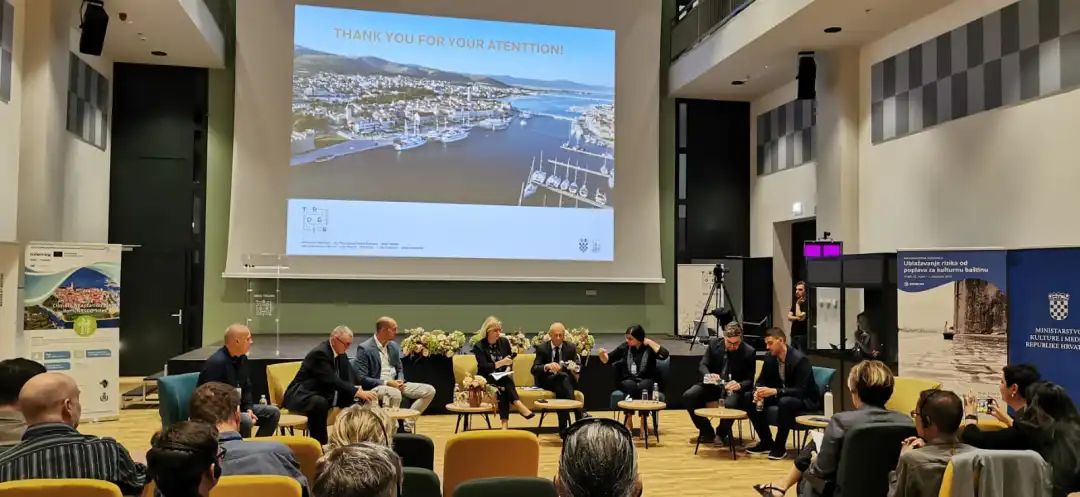
关键缺口
1.尽管文化遗产在各种国家战略文件中得到了认可,但在基层有效实施方面仍存在显著缺口,特别是在促进跨部门和跨机构合作方面。
2.洪水造成的经济损失超过了韧性投资。
3.文化遗产部门与气候科学界之间的合作有限,不同层级和部门之间的协作不足。
4.决策者对洪水风险和韧性策略的认知水平低,阻碍了有效行动的开展。
5.数据不足,无法准确评估和定价洪水风险。
6.对洪水风险和损失的低估导致了减缓努力被视为不必要的观念。
解决方案指南
为了解决这些关键问题,提出了以下解决方案:
·拥抱创新:结合新技术和传统技术。
·改变机构行为:促进机构之间的合作与沟通文化。
·创建可持续商业模式:修订城市和乡村规划流程,以优先考虑抗灾韧性。
·确保资源管理高效:优化资源配置以取得最大化效应。
·促进研究与创新:加大对气候韧性研究和文化遗产保护的投资。
·利用传统知识:将地方知识和实践融入现代韧性策略中。
·教育和提高意识:实施教育项目,特别是针对年轻人的项目,以培养警惕和备灾文化。
·将文化遗产纳入主流:将文化遗产和气候科学整合到各级战略规划中。
·提供灾害风险培训:为地方当局和社区提供培训项目,以增强应对准备。
·建立强有力的法规:制定支持洪水风险缓解努力的稳健监管框架。
·制定地方政策:制定满足特定需求和抗灾脆弱性的地方政策。
·任命国家协调员:指定国家协调员以监督和协调洪水风险管理工作。
PART.03
案例总结

与乌格里扬岛渔民的故事圈:
将传统知识融入洪水风险管理
作为课程致力于社区基础方法的一部分,与克罗地亚乌格里扬岛的渔民博兹达尔·布拉斯洛夫举行了一个故事圈活动。此次会议旨在将前线渔业社区的声音纳入洪水风险管理的讨论中。乌格里扬岛的渔民长期以来积累了关于天气模式和风暴预测的宝贵知识,这些知识帮助他们规划捕鱼活动并减轻风险。
他分享了社区为应对风暴和天气变化所采用的传统方法。这些代代相传的做法凸显了地方知识在洪水风险管理中的重要价值。参与者们由此受到启发,并开始尝试在自己的文化遗产项目中采用类似的社区驱动方法。
特罗吉尔的抗灾脆弱性和能力评
估:让当地居民参与洪水风险管理
参与者使用ICCROM-FAR的inSIGHT工具进行了参与式脆弱性和能力评估(VCA),该评估吸引了超过35名当地社区成员,包括店主、儿童和地方官员的参与。该活动强调了将文化遗产融入洪水风险规划的重要性,确保当地声音能够指导决策,并增强社区对洪水的抵御能力。
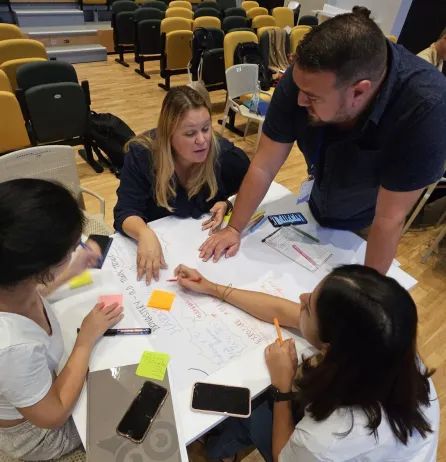
PART.04
最终情景演练

在特罗吉尔的本笃会修道院进行的洪水模拟中,利用3D可视化和实地演练让参与者进行了一次视觉学习体验,并将所学知识应用于现实的洪水应对场景。此次演练强调了在紧急情况下有效的与利益相关者沟通和合作的重要性。特罗吉尔市市长和当地消防员的见解进一步突显了在危机时期团队合作和沟通在保护文化遗产中的关键作用。
PART.05
展望未来

随着我们直面气候变化的现实,从本课程中学到的经验教训将跨越国界,确保文化遗产在未来几代人中得到保护。展望未来,参与者将在接下来的六个月内审查他们的行动计划,并在各自地点实施洪水风险缓解措施。他们将被鼓励与当地社区和网络分享自己的经验和发现,从而扩大培训的影响力。通过持续与利益相关者互动并提高对洪水风险的认识,我们可以共同建立一种更具韧性的文化遗产保护方法。
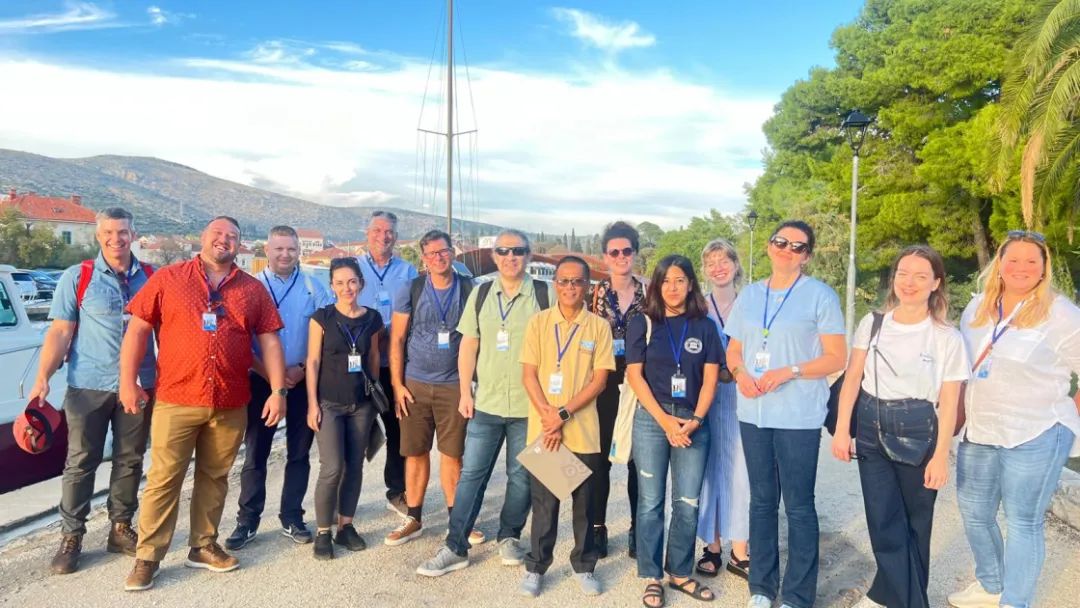
课程:PREVENT – 文化遗产洪水风险缓解
更多详情信息参见:
https://www.iccrom.org/news/tackling-floods-global-threat-cultural-heritage
Mitigating Flood Risk for Cultural Heritage Course leaps forward to safeguard diverse forms of heritage from flood risks.
From September 22 to 30, 2023, ICCROM's First Aid and Resilience for Cultural Heritage in Times of Crisis (FAR) programme organized a blended course on flood risk mitigation in Trogir, Croatia. Organized in partnership with the Ministry of Culture and Media of the Republic of Croatia, with the generous support of the Canadian Conservation Institute (CCI) and the National Cultural Heritage Administration of China, this course brought together 14 participants from six countries: Canada, Croatia, Malta, India, Poland and Romania all facing imminent flood risks exacerbated by various factors, including climate change and urbanization.
Flooding has become one of the most severe and frequent threats to cultural heritage worldwide. The course PREVENT: Mitigating Flood Risk for Heritage, the second in our PREVENT series following the success of our 2022 fire risk mitigation course, has been designed to address this growing challenge. This year's focus on flooding highlights the urgent need for immediate, collective action to protect all forms of heritage.
Through the PREVENT series, we aim to foster collaboration among diverse professionals, providing them with specialized training and resources to address the unique challenges of flood risk management in their regions. The training emphasizes understanding the contributing factors of flood risks and implementing cost-effective mitigation and emergency preparedness strategies at heritage sites.
PART.
01
A collaborative
learning experience

Before the in-person component, participants engaged in an online orientation covering vital concepts, including the intersection of disasters and climate change, risk assessment components, and global case studies highlighting climate change's impact on cultural heritage.
During the week-long course, participants participated in both theoretical discussions and hands-on simulations. They focused on assessing flood risks at heritage sites, analyzing vulnerabilities, and developing risk scenarios. The course also emphasized the importance of traditional knowledge, community-led strategies, and emergency responses to heritage site flooding. By the course's end, each team had developed a detailed action plan to mitigate flood risks specific to their heritage sites or institutions.
PART.
02
Key Highlights
from the Course

The course officially opened with remarks from ICCROM's Director-General, Ms. Aruna Francesca Maria Gujral, alongside Mr. Tomislav Petrinec, Director of the Directorate for the Protection of Cultural Heritage at the Ministry of Culture and Media in Croatia, and Trogir's mayor, Ante Bilić. They highlighted the urgent need for proactive risk management in safeguarding heritage against extreme weather events.
The course featured a mayors' roundtable on Trogir's current flood risks, management plans, and the gaps in protecting its heritage. This discussion revealed the challenges historic cities' challenges and the need for more robust heritage protection measures.
Key gaps identified
1.Despite cultural heritage being recognized in various national strategic documents, there remains a significant gap in effective implementation at the ground level, particularly in fostering cross-sectoral and inter-institutional cooperation.
2.Economic losses from floods surpass resilience investments.
3.Limited cooperation between the cultural heritage sector and climate science communities and insufficient collaboration across different levels of authority and sectors.
4.The low level of awareness about flood risks and resilience strategies among decision-makers hinders effective action.
5.Insufficient data to accurately assess and price flood risks.
6.Underestimation of flood risks and losses leads to a perception that mitigation efforts are unnecessary.
Guidelines to solutions
To address these key issues, the following solutions were proposed:
·Embrace innovation:
Incorporate both new and traditional technologies.
·Change institutional behaviour:
Foster a culture of collaboration and communication among institutions.
·Create sustainable business models:
revise city and rural planning processes to prioritize resilience.
·Ensure efficient resource management:
Optimize resource allocation to maximize impact.
·Promote research and innovation:
Invest in climate resilience research and cultural heritage preservation.
·Leverage traditional knowledge:
Integrate local knowledge and practices into modern resilience strategies.
·Educate and raise awareness:
Implement education programmes, especially targeting young people, to foster a culture of preparedness and awareness.
·Mainstream cultural heritage:
Integrate cultural heritage and climate science into strategic planning at all levels.
·Provide disaster risk training:
offer training programmes for local authorities and communities to enhance preparedness.
·Establish strong regulations:
Develop a robust regulatory framework that supports flood risk mitigation efforts.
·Create local policies:
formulate localized policies that address specific needs and vulnerabilities.
·Appoint a National Coordinator:
designate a national coordinator to oversee and streamline flood risk management efforts.
PART.03
Case summary

Story circle with a Fisherman from Ugljan Island: Integrating Traditional Knowledge in Flood Risk Management
As part of the course's commitment to community-based approaches, a story circle was held with fisherman Bozidar Blaslov from Ugljan Island, Croatia. This session aimed to bring the voices of frontline fishing communities into the conversation on flood risk management. Fishermen, like him, have long held valuable knowledge about weather patterns and storm forecasting, which they use to plan their fishing activities and mitigate risks.
He shared traditional methods his community uses to prepare for storms, and prepare for weather changes. These practices, passed down through generations, highlight the value of local knowledge in flood risk management. Participants were inspired to explore similar community-driven approaches in their own heritage projects.
Vulnerability and capacity assessment in Trogir: engaging locals in flood risk management
Participants engaged in a participatory Vulnerability and Capacity Assessment (VCA), using ICCROM-FAR's inSIGHT tool, engaging over 35 local community members, including shopkeepers, children, and local officials. The activity emphasized the importance of integrating cultural heritage into flood risk planning, ensuring that local voices guide decision-making and enhance community resilience against flooding.
PART.
04
Final Scenario-Based
Simulation Exercise

A flood simulation at Trogir's Benedicte Monastery, using 3D visualizations and walkthroughs, enabled participants to engage in a visual learning experience and apply their acquired knowledge to real-life flood response situations. This exercise highlighted the importance of effective stakeholder communication and collaboration during emergencies. Insights from Trogir's mayor and local firefighters reinforced the critical role of teamwork and communication in protecting cultural heritage during times of crisis.
PART.05
Moving Forward

As we confront the realities of climate change, the lessons learned from this course will resonate across borders, ensuring that heritage remains protected for generations to come. Moving forward, participants will review their action plans and implement flood risk mitigation measures at their respective sites over the next six months. They will be encouraged to share their experiences and findings with their local communities and networks, amplifying the impact of their training. By continuing to engage stakeholders and promote awareness about flood risks, we can collectively build a more resilient approach to heritage conservation.
Courses: PREVENT – Mitigating Flood Risk for Heritage
For More Details See:
https://www.iccrom.org/news/tackling-floods-global-threat-cultural-heritage

扫码关注
亚洲遗产管理学会
Asian Academy for
Heritage Management
